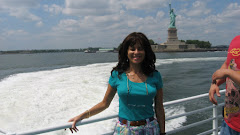









Today, I visited Rhodes, a walled city that is the largest permanently inhabited medieval city in Europe. Rhodes is the name of the city as well as the Aegean island and consists of three different cities: ancient, medieval, and modern and the old town is a UNESCO World Heritage Site. Of course, it is best known for the Colossus of Rhodes, one of the seven Wonders of the Ancient World, that stood in the old harbor until it collapsed in an earthquake in 227 BC, after dominating the harbor for 56 years. It is also known for its splendid beaches and 300 days of sunshine a year.
As I left the ship, I noticed Hop On Hop Off Buses just outside the port entrance (stop #8). Although I had studied all the maps and planned to take a self-guided tour of the Old Town, I decided to begin my journey with an hour long scenic circuit of the entire city (including up to Monte Smith) atop the tour bus, listening to a guided lecture. As always, I learned a lot and succeeded in getting an overview of both old and new, I would not have been able to conquer on foot.
Once I was satisfied I had a nice overview, I descended the bus (at stop #6) close to the stop where I boarded and near the Old Town central market, adjacent to the knights quarter. This was the perfect starting point for my walking tour of the (mostly pedestrian-only) Old Town. The well-preserved old town is divided into 3 quarters: knights, Turkish, and Jewish. I explored all 3.
The Avenue of the Knights, Ipoton, is the main thoroughfare of the knights’ quarter. This street is lined with the imposing Inns, residences of Knights of the Order of St John, that are divided by linguistic affinity, from each of the 7 groups that occupied Rhodes. I saw the French, Spanish, and Italian Inns, all that house archeological and decorative arts museums. I will explore Rhodes’ many museums on my next visit.
From here, I walked straight uphill to the Palace of Grand Masters, an imposing fort; built to be the last line of defense should the outer walls of the city be breached. Built on the site where the ancient Greek temple of Apollo stood, it was the residence of the Grand Master of the Knights, and where the Order assembled. After Rhodes fell to the Turks in 1522, it was converted to a prison and the palace was completely destroyed by an accidental explosion of stored black powder in 1856.
What is visible today as the Palace of the Grand Masters was rebuilt in the 1930’s based upon old drawings and it’s the complete reconstruction was undertaken to create the summer residence of Mussolini and King Victor Emmanuel III. Of note, it was never used for this purpose.
Next, I climbed the hill of the Mosque of Suleiman that was built soon after the Turks occupied the city of Rhodes in 1522 on the site of the destroyed Christian Church of the Apostles.
Just in front of the Suleiman Mosque is the old Turkish Bazaar that lines Sokratous Street, which is packed with tourists and a melee of shops that spill their wares into the street. I enjoyed exploring and bargaining. The shop owners are not annoyingly aggressive as in certain other cities.
Sokratous Street is a pleasant cobblestone street that is bound to be walked by every tourist who visits Rhodes. I took a slow walk through this street from the Mosque of Suleiman to the very lively Ippokratous Square which surrounds the Castellania fountain (birds are actually drinking from each of the faucets!!), and is framed by the old Chadrevan mosque on the west and the Palace of the Castellan on the east. All around, coffee shops and terraced-restaurants burst at the seams as they spill onto the street having completely covered the old buildings.
I returned to the ship to recharge my camera battery, find my ATM card, and grab lunch. I went back into Old Town for another 2 hours to explore more of the maze of nooks and crannies of this remarkably charming town.
When I return, I will take a trip to Lindos.
Tweet: Rhodes is the perfect port city: rich in history, U walk there from ship, it’s beautiful, it’s unique: a medieval walled-city & people smile






.jpg)
.jpg)




No comments:
Post a Comment